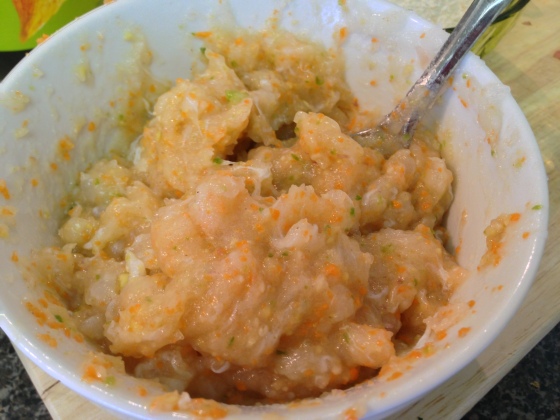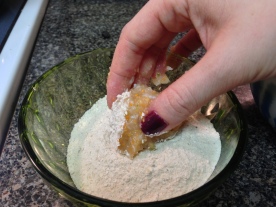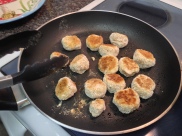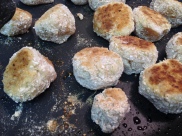Traditional fish paste is made with minimal ingredients. To sum up
the process, you are scraping all the meat from a fish (or fishes) and
pounding it until it reaches the right consistency. There is a lot of
technique to the pounding part (I still need a lot of practice). You’ve
got to do it for the right amount of time to achieve the perfect fish
balls with that “bouncy”, “springy” consistency. Here is my recipe and
the results of my first attempt. This was also my first time gutting a
fish…which wasn’t as gory as I thought it would be. I saved the heads,
tails and bones and made a delicious fish broth for grandmother by
simply boiling in water with some ginger and onions.

Get ready to slam that fish paste! A great way to de-stress and release some tension!
Traditional Chinese Fish Ball Recipe
*A wooden cutting board may absorb the smell of the fishl and take
longer to clean, use a plastic cutting board for less fishiness. (I was
smelling fish for a few days…)
Also, you may want to work over newspaper to avoid fish bits getting everywhere.
Ingredients
- 2 whole Spanish mackerels, about 1 pound each **I have seen others
use different fish, you can try this with any white fish. If you really
don’t want to use a whole fish you could try this with just fillets as
well. You can also cut this recipe in half if you want to try with just
one small fish.
- 1 teaspoon salt (or to taste)
- 1/2 teaspoon ground white pepper (or to taste)
- 1 tablespoon cornstarch
- Water



1. Clean your fish. Spanish mackerel has no scales which made it easy for me. Ask the fish monger to de-scale your fish if you have chosen to use a fish with scales. Make a slit along the belly from the fish’s rectum up to where the head begins. Remove all the innards and discard. It’s really quite simple. Rinse the fish in cold water, dry and place on cutting board. Use a plastic cutting board if you don’t want to stink up your wooden one!


2. Remove fish head(s). Simply chop the heads off. Discard, or save if you want to use them to make broth.




3. Filet the fish. Slice the meat off the fish along the bones from the tail forwards towards the head using a sharp knife. Repeat on the other side as well. (2 filets per fish.)





4. Using a spoon, scrape the flesh from the skin of the filets as well as off of the remaining fish bones. You ultimately want all the meat separated, without bones or skin. Be careful of small bones! You don’t want any bones in your fish paste!







5. Place all the flesh on a cutting board and season with salt and white pepper. I used 3/4 of the teaspoon of salt and about 1/2 teaspoon white pepper.
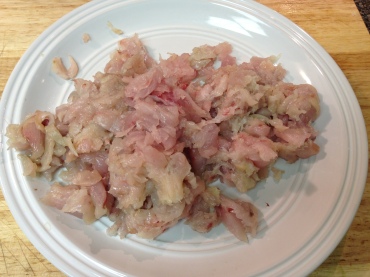


6. Add the approx. 1/4 teaspoon salt you have left to about 1/3 cup of water and set aside for later use.

7. Using the back of a big chopping knife, begin chopping/breaking up the fish. Keep an eye out for any bones to remove. (Note: if you want to save time you could use a food processor.)





8. The fish will develop a slightly sticky consistency as you continue to chop. Add the salted water bit by bit while chopping. This will make it easier and less sticky.
9. Now for the most important part! When your fish is evenly chopped, with no big chunks, you will gather the ball of fish paste and begin the throwing/slamming process. Repeatedly pound the fish paste onto the cutting board. This is the key to making “springy” or “bouncy” fish balls. I’d say I slammed mine about 50 times. Watch for flying fish bits! **




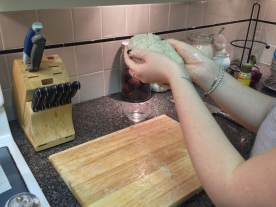
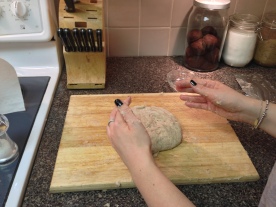
10. When you are done pounding the paste, add a little water to your 1 tablespoon of cornstarch in a small bowl, just enough that it liquifies. Add this to the fish paste and knead until combined well.


11. Your fish paste should be smooth and soft. When you’re finished, wet your hands and apply a little bit of water to the surface of your fish paste ball and you will notice it becomes smooth and shiny. You have done well!


12. You can test out your paste by dropping a spoonful into boiling water. When it floats, it’s cooked! Have a taste. You can add more seasoning, chop or pound more as needed.

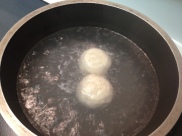

13. To make fish balls, take the paste in your hands and shape into balls. They are usually about a tablespoon of fish paste each.
14. Storage: You can separate your fish paste however you like, and keep in the freezer. If you want to freeze it in fish ball form, I suggest lining a baking tray with parchment paper, place the fish balls in a single layer on the parchment, cover with foil to avoid having your freezer smell like fish and then allow them to freeze in a few hours or overnight. You can then take the fish balls off the tray and keep them frozen in a container or bag of your choice.


**In regards to the “throwing” of the fish paste, I’ve heard people throw 10 times and I’ve heard throw 70 times. It takes practice to make perfect fish paste and also comes down to personal preference. Keep experimenting to master a perfect paste for you!

I hope you enjoy this recipe! It was a fun learning experience and taught me a little more about my own heritage which was really nice. You can always get creative and add extra ingredients to your fish paste before cooking. Adding ingredients like green onions or ham are more common, but let your imagination run wild! I’m sure you can come up with something tasty!
Credit: https://thishungrykitten.com/2013/11/14/homemade-chinese-fish-balls-the-way-they-should-be-made/





